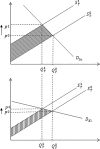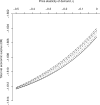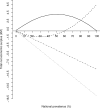A framework for estimating society's economic welfare following the introduction of an animal disease: The case of Johne's disease
- PMID: 29874292
- PMCID: PMC5991423
- DOI: 10.1371/journal.pone.0198436
A framework for estimating society's economic welfare following the introduction of an animal disease: The case of Johne's disease
Erratum in
-
Correction: A framework for estimating society's economic welfare following the introduction of an animal disease: The case of Johne's disease.PLoS One. 2018 Aug 9;13(8):e0202253. doi: 10.1371/journal.pone.0202253. eCollection 2018. PLoS One. 2018. PMID: 30092015 Free PMC article.
Abstract
Animal diseases are global issues affecting the productivity and financial profitability of affected farms. Johne's disease is distributed on farms worldwide and is an endemic contagious bacterial infection in ruminants caused by Mycobacterium avium subspecies paratuberculosis. In cattle, the clinical disease manifests itself as chronic enteritis resulting in reduced production, weight loss, and eventually death. Johne's disease is prevalent in the UK, including Scotland. Direct costs and losses associated with Johne's disease have been estimated in previous research, confirming an important economic impact of the disease in UK herds. Despite this, the distributional impact of Johne's disease among milk consumers and producers in Scotland has not been estimated. In this paper, we evaluate the change in society's economic welfare, namely to dairy producers (i.e. infected and uninfected herds) and milk consumers in Scotland induced by the introduction of Johne's disease in the national Scottish dairy herd. At the national-level, we conclude that the economic burden falls mainly on producers of infected herds and, to a lesser extent, milk consumers, while producers of uninfected herds benefit from the presence of Johne's. An infected producer's loss per cow is approximately two times larger in magnitude than that of an uninfected producer's gain. Such economic welfare estimates are an important comparison of the relative costs of national herd prevalence and the wider economic welfare implications for both producers and consumers. This is particularly important from a policy, public good, cost sharing, and human health perspective. The economic welfare framework presented in this paper can be applied to other diseases to examine the relative burden of society's economic welfare of alternative livestock disease scenarios. In addition, the sensitivity analysis evaluates uncertainty in economic welfare given limited data and uncertainty in the national herd prevalence, and other input parameters, associated with Johne's disease in Scotland. Therefore, until the prevalence of Johne's is better understood, the full economic cost to Scottish dairy herds remains uncertain but in the meantime the sensitivity analysis evaluates the robustness of economic welfare to such uncertainties.
Conflict of interest statement
The authors have declared that no competing interests exist.
Figures







References
-
- Barkema HW, Hesselink JW, McKenna SL, Benedictus G, Groenendaal H. Global prevalence and economics of infection with Mycobacterium avium subsp paratuberculosis in ruminants. In: Behr MA, Collins DM, editors. Paratuberculosis: Organism disease control Wallingford: CAB International; 2010. p. 10–21.
-
- Collins MT. Update on paratuberculosis: 1. Epidemiology of Johne's disease and the biology of Mycobacterium paratuberculosis. Ir Vet J 2003;56(11):565–574.
-
- Windsor PA, Whittington RJ. Evidence for age susceptibility of cattle to Johne’s disease. Vet J 2010;184(1):37–44. doi: 10.1016/j.tvjl.2009.01.007 - DOI - PubMed
-
- Larsen AB, Merkal RS, Cutlip RC. Age of cattle as related to resistance to infection with Mycobacterium paratuberculosis. Am J Vet Res 1975. March;36(3):255–257. - PubMed
-
- Begg DJ, O'brien R, Mackintosh CG, Griffin JF. Experimental infection model for Johne's disease in sheep. Infect Immun 2005;73(9):5603–5611. doi: 10.1128/IAI.73.9.5603-5611.2005 - DOI - PMC - PubMed
Publication types
MeSH terms
LinkOut - more resources
Full Text Sources
Other Literature Sources

